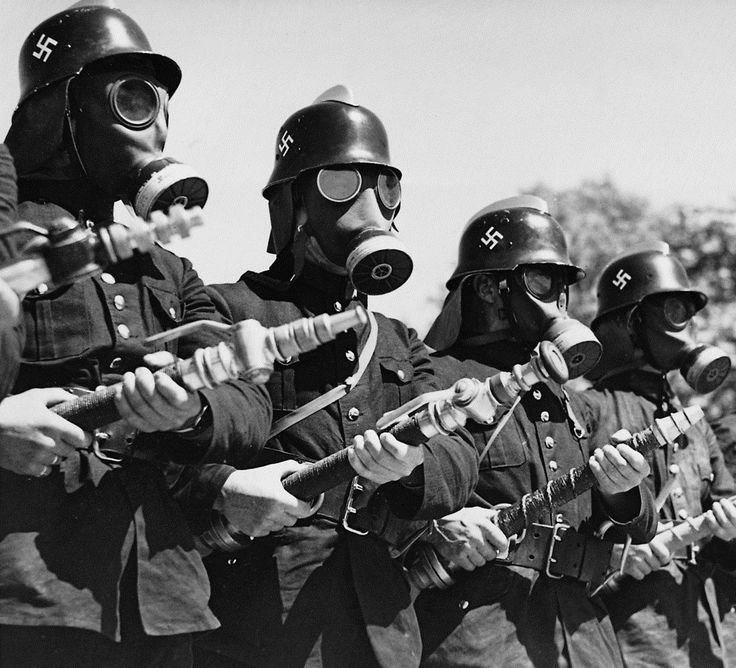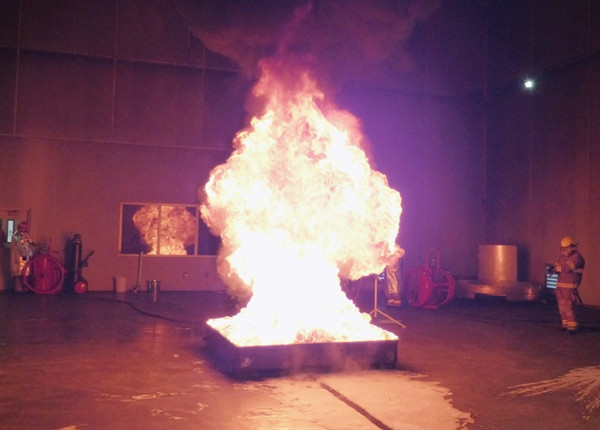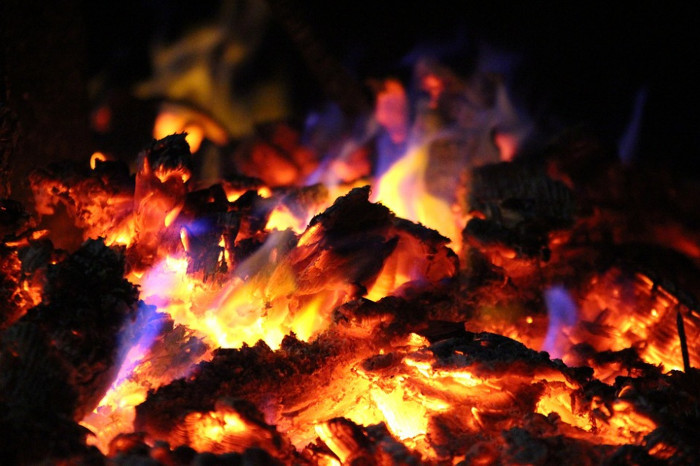These are the 5 most horrible chemicals in history
These chemicals have a tremendous amount of devastation that no one can imagine.
Thanks to chemistry, people have invented many new substances to serve their needs. Some of them are quite safe and widely used in life.
However, for some reason, some substances are created with extremely . horror characteristics. If you haven't figured it out yet, the following article will help you do this.
1. Chemicals N - Fire comes from "hell"

For some reason, some chemicals are created with extremely . horror characteristics.
Legend has it that: Nazi Germany once produced an extremely horrible chemical codenamed N during World War II. The substance N has boiling properties when exposed to air, exploding when touched, causing death if inhaled, decomposing to produce toxic acid. In particular, when loaded into a flamethrower and fired, N can create flames at temperatures up to 2,400 degrees Celsius.

The substance N is chlorine trifluoride (ClF 3 ).
The Nazis wanted to use N to turn the Allied army bunkers into "porridge" literally. However, after the study period, the German soldiers themselves did not dare to use it because of the high danger of the substance N. Therefore, the study ended.
That is the legend. In fact, however, this is a true story, and N is chlorine trifluoride (ClF 3 ) , the most powerful fluoride agent known to man.

ClF 3 can burn materials that rewards can not burn like bricks, tiles .
Because of its superior oxidation properties to oxygen, ClF 3 can burn materials that reward bottles cannot burn like bricks, asbestos . And also because of the superhuman burning ability, chlorine trifluoride used to be used by American scientists to create rocket propulsion, but they soon realized their luck after an incident in 1950.

There is no way to extinguish the fire except to let it . burn itself out.
At that time, American scientists tried to transport chlorine trifluoride in large quantities inadvertently broke a steel container. Immediately, tons of ClF 3 burned violently. The extremely hot fire not only penetrates the 30cm thick concrete layer of the floor but also continues through the 1 meter soil and gravel below. There is no way to extinguish the fire except to let it . burn itself out.
The danger is that, but now this chemical is still produced and used in semiconductor companies to clean some devices without having to dismantle them.
2. Azidoazide azide (C 2 N 14 ) - "Do not touch" also explodes
Azidoazide azide (C 2 N 14 ) or AA , is the most explosive compound ever made by humans. If the above mentioned N is a superfluous substance, AA is a super explosive.

Azidoazide azide is the most explosive compound ever made by humans.
As we learned, a nitrogen atom tends to pair with another nitrogen atom through a triple bond, and the NEN bonding type is one of the strongest links on Earth, so it is common in Naturally, the pair of nitrogen atoms is only separated when lightning strikes.
But this same strength also shows that the energy source when two Nitrogen atoms are attached to each other will be very large. As for AA, there are up to 14 nitrogen atoms but no atoms have triple bonds, making the molecule in a high-energy state and loosely coupled. This property leads to AA having both characteristics: extremely explosive and explosive.

AA is explosive to the explosive sensitivity of this substance beyond the measurement capacity of humans.
AA is explosive to the explosive sensitivity of this substance beyond the measurement capacity of humans. In 2010, a group of German chemists listed the action of AA detonation, which included very small actions such as . teleporting, or impacting from light, or not doing It also exploded.
3. Dimethyl cadmium (CH 3 -CO-CH 3 ) - Inhalation is dead
Dimethyl cadmium (CH 3 -CO-CH 3 ) is a metal organic compound. It also has both frightening properties that fire is hard to extinguish and explode , but its frighteningness comes from the toxic concentration it gives . Only a few millionths of a gram of dimethyl cadmium vapor dispersed in a 1-cubic-meter volume were enough to kill a person.

Dimethyl cadmium is a fire compound that is difficult to extinguish and explosive.
The toxicity of dimethyl cadmium causes both acute and chronic effects on the human body. When inhaled, the toxin quickly absorbs into the blood, thereby spreading throughout the body, causing almost immediate effects on organs such as the lungs, liver, and kidneys.

Dimethyl cadmium quickly spreads along the blood stream and destroys body cells.
Even if the victim is still alive for a few hours after inhaling this gas, the aftermath is also terrible.This poison is a powerful carcinogen. Heard here, you can imagine how devastating the power of Dimethyl cadmium is.
So if you accidentally spill out dimethyl cadmium, how do you clean it - it's best to never let that happen. Because using wash water, or scanning is not possible because it stimulates an explosion reaction. Even waiting for decomposing dimethyl cadmium is not feasible, because the newly created substance is more explosive than the original substance.
4. Thioacetone (C 3 H 6 S) - The most rotten . substance you can imagine
Thioacetone (C 3 H 6 S) seems to be the most pleasant chemical on this list, because it does not cause fire, explosion, or cancer. However, if you have a chance to be exposed to thioacetone, you will immediately have to run away for kilometers. Because this is the substance that won the title "The most smelly substance in the world".

Compared to thioacetone, your stinking shoes are still "scented".
Thioacetone and other -thiol-based organic compounds have a carbon atom linked to the –SH group, and they almost all have a "pretty" odor . For example, the skunks of skunks contain two different thiol compounds, or the smell of rotten meat is similar.
But after all, the new thioacetone is really special, because it has a super-heavy smell, which can cause a person to grimace in a radius of half a kilometer.
One of the cases that represents the "unrivaled" scent of thioacetone was in 1889, in the German city of Freiburg.
A chemical and soap factory tested tri-thioacetone for use as a scent. However, when they broke this molecule, the workers began to feel sick, there was uncontrollable vomiting in the neighborhood neighborhood houses, and then the entire city moved. dissipation!

Smelling the smell of thioacetone, humans may fall into an involuntary vomiting state.
5. Fluoroantimonic acid (H 2 FSBF 6 ) - "Dad" of acid
In terms of danger, fluoroantimonic acid (H2FSbF6) is probably the most dangerous acid ever made by humans.
According to chemical rules, fluoroantimonic acid is more acidic . 10 million billion (10 caps 16) times than sulfuric acid (H 2 SO 4 ), the acid is considered to be the most powerful of the common acids.

Concentrated sulfuric acid is extremely destructive but has not been absorbed in comparison with super acid.(in the picture: reaction of concentrated sulfuric acid with sugar).
And it will be scary if a person with fluoroantimonic acid falls on him. Since fluorine in fluoroantimonic acid tends to prefer to bind to calcium, after it destroys tissues in the skin and muscles, fluoroantimonic acid will continue to burn through the bone.This acid is so strong that gold must also melt in it.

The only thing that can be used to store fluoroantimonic acid is teflon containers.
The only thing that can be used to store fluoroantimonic acid is teflon containers , because this polymer is made up of carbon-fluorine bonds, which is the strongest inorganic single bond in chemistry.
- 6 chemicals in food and cosmetics are unjustly 'dangerous'
- Chemical substances 'not strange' cause gender change
- Chemicals in objects cause many diseases for children
- Pregnant women and chemicals
- Not Zika but Monsanto's chemicals cause brain atrophy?
- Harm of chemicals on 5 parts of the body
- American experts warn of 'permanent chemicals' that cause cancer in food
- What size of poisonous fruit ripening chemicals?
- Suspecting toxic chemicals ... causing infertility on clothes
- Chemicals in soap can make men infertile
- Warning: Food packaging contains more than 175 dangerous chemicals
- There is a chemical element applied for decades that turned out to never exist
 'Fine laughs' - Scary and painful torture in ancient times
'Fine laughs' - Scary and painful torture in ancient times The sequence of numbers 142857 of the Egyptian pyramids is known as the strangest number in the world - Why?
The sequence of numbers 142857 of the Egyptian pyramids is known as the strangest number in the world - Why? History of the iron
History of the iron What is alum?
What is alum? How to eliminate uric acid from the body?
How to eliminate uric acid from the body?  Plants know how to produce their own emergency pain reliever
Plants know how to produce their own emergency pain reliever  What is Klamentin 875/125?
What is Klamentin 875/125?  Surprise with teeth whitening technology in the 19th century
Surprise with teeth whitening technology in the 19th century  The truth about 3 taboo foods to eat with potatoes, this is the one thing that shouldn't be eaten the most
The truth about 3 taboo foods to eat with potatoes, this is the one thing that shouldn't be eaten the most  The reactor converts greenhouse gas emissions into fuel
The reactor converts greenhouse gas emissions into fuel 